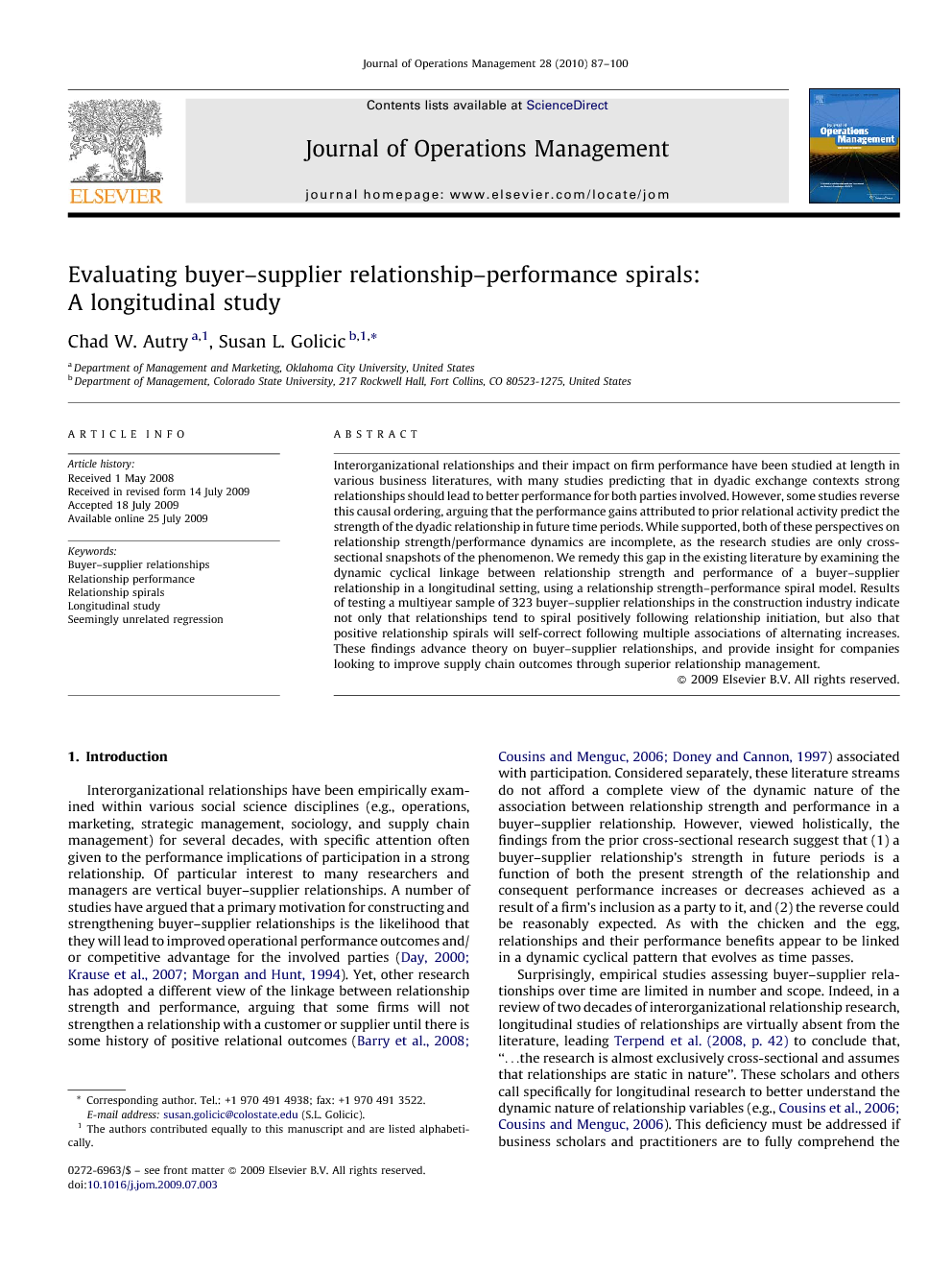Interorganizational relationships and their impact on firm performance have been studied at length in various business literatures, with many studies predicting that in dyadic exchange contexts strong relationships should lead to better performance for both parties involved. However, some studies reverse this causal ordering, arguing that the performance gains attributed to prior relational activity predict the strength of the dyadic relationship in future time periods. While supported, both of these perspectives on relationship strength/performance dynamics are incomplete, as the research studies are only cross-sectional snapshots of the phenomenon. We remedy this gap in the existing literature by examining the dynamic cyclical linkage between relationship strength and performance of a buyer–supplier relationship in a longitudinal setting, using a relationship strength–performance spiral model. Results of testing a multiyear sample of 323 buyer–supplier relationships in the construction industry indicate not only that relationships tend to spiral positively following relationship initiation, but also that positive relationship spirals will self-correct following multiple associations of alternating increases. These findings advance theory on buyer–supplier relationships, and provide insight for companies looking to improve supply chain outcomes through superior relationship management.
Interorganizational relationships have been empirically examined within various social science disciplines (e.g., operations, marketing, strategic management, sociology, and supply chain management) for several decades, with specific attention often given to the performance implications of participation in a strong relationship. Of particular interest to many researchers and managers are vertical buyer–supplier relationships. A number of studies have argued that a primary motivation for constructing and strengthening buyer–supplier relationships is the likelihood that they will lead to improved operational performance outcomes and/or competitive advantage for the involved parties (Day, 2000, Krause et al., 2007 and Morgan and Hunt, 1994). Yet, other research has adopted a different view of the linkage between relationship strength and performance, arguing that some firms will not strengthen a relationship with a customer or supplier until there is some history of positive relational outcomes (Barry et al., 2008, Cousins and Menguc, 2006 and Doney and Cannon, 1997) associated with participation. Considered separately, these literature streams do not afford a complete view of the dynamic nature of the association between relationship strength and performance in a buyer–supplier relationship. However, viewed holistically, the findings from the prior cross-sectional research suggest that (1) a buyer–supplier relationship's strength in future periods is a function of both the present strength of the relationship and consequent performance increases or decreases achieved as a result of a firm's inclusion as a party to it, and (2) the reverse could be reasonably expected. As with the chicken and the egg, relationships and their performance benefits appear to be linked in a dynamic cyclical pattern that evolves as time passes.
Surprisingly, empirical studies assessing buyer–supplier relationships over time are limited in number and scope. Indeed, in a review of two decades of interorganizational relationship research, longitudinal studies of relationships are virtually absent from the literature, leading Terpend et al. (2008, p. 42) to conclude that, “…the research is almost exclusively cross-sectional and assumes that relationships are static in nature”. These scholars and others call specifically for longitudinal research to better understand the dynamic nature of relationship variables (e.g., Cousins et al., 2006 and Cousins and Menguc, 2006). This deficiency must be addressed if business scholars and practitioners are to fully comprehend the dynamic linkage between relationship strength and its antecedents and outcomes. The issue is particularly important for the discipline of supply chain management, where nexuses of exchange relationships among multiple customer and supplier firms drive the success of entire industries, and yet evaluations of relationship strength and its dynamic linkage to performance are virtually non-existent to date.
The purpose of this study is to conceptually and empirically address gaps in buyer–supplier relationship theory by (1) specifically examining how buyer–supplier relationships may become stronger or weaker over time as a result of prior performance successes or failures, and (2) simultaneously assessing how performance is cyclically impacted by changes in relationship strength throughout the duration of a buyer–supplier relationship. Moving toward these goals, we first review existing literature related to relationship strength, and then integrate multiple theory bases supporting that its interaction with performance over time should result in a spiraling pattern exhibited as an amplifying and/or self-correcting cycle. We next offer hypotheses predicting specified attributes of relationship spirals, and test these using longitudinal firm level panel data depicting 323 vertical buyer–supplier relationships within the context of the highway construction industry. Based on our findings, we conclude by discussing important implications for managers and future research.


